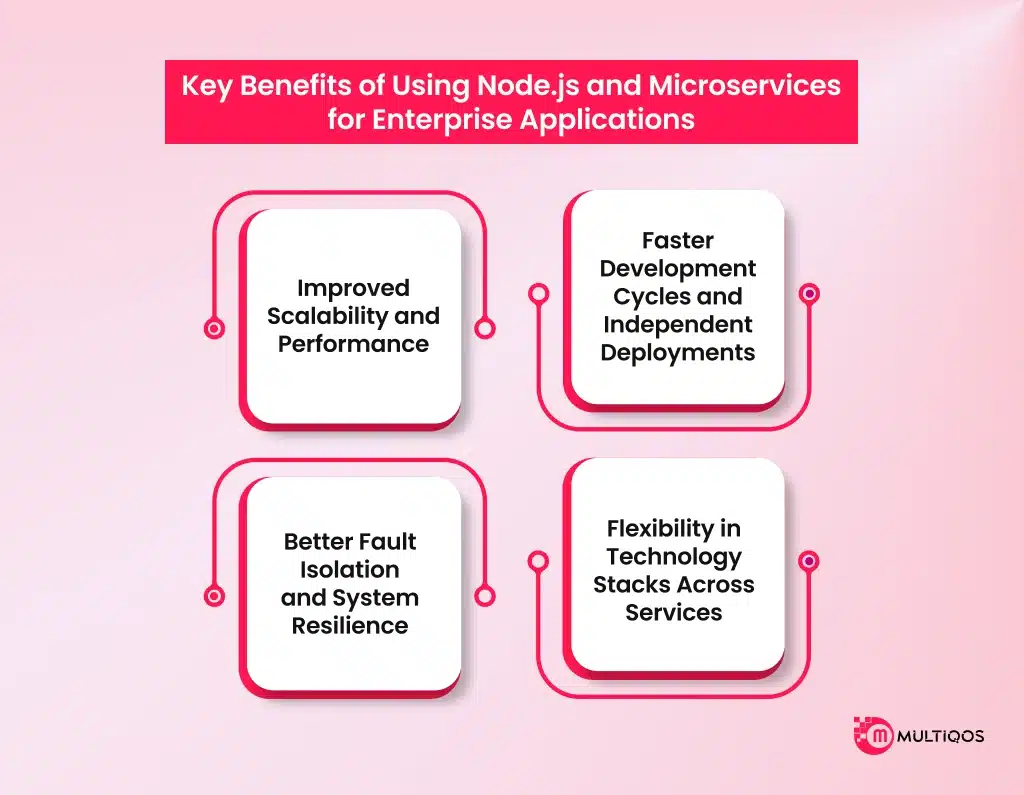Building Scalable Enterprise Applications with Node.js and Microservices

Summary:
Building enterprise applications with Node.js and microservices offers a powerful approach to achieving scalability, flexibility, and high performance. This blog delves into how Node.js—known for its event-driven, non-blocking architecture—serves as an ideal choice for enterprise-grade systems.
By adopting a microservices architecture, developers can break down monolithic applications into smaller, independent services that can be developed, deployed, and scaled individually. The article also discusses best practices and key benefits such as improved development speed, better resource utilization, and enhanced fault isolation. It’s a practical guide for enterprises aiming to modernize their application stack with Node.js.
Introduction
With the recent developments in technology, businesses have faster and more sophisticated software solutions that can be easily scaled. To keep up with these modern needs, companies are now adopting modern approaches by choosing Node.js development as a dependable platform for system development.
Enterprise apps require speed, flexibility, and adaptivity to evolving circumstances, which is where Node.js excels.
In this blog, we look at how enterprise applications with Node.js and microservices architecture can be implemented, focusing on flexibility, reliability, and effortless scaling.
It doesn’t matter if you are updating an existing system or creating one from scratch; this guide will highlight the benefits of using Node.js and microservices architecture for enterprise-grade applications.
Understanding Microservices Architecture
Microservices architecture defines an application as a composition of fine-grained, loosely coupled, and self-contained services that can be developed and deployed independently. Services interact with one another using simple methods. Each service offers a specific business function, and it communicates with other services through standard networks such as HTTP or messaging queues.
This structure improves agility, scalability, and fault tolerance—all exceedingly useful when it comes to web development. Unlike monolithic architectures, microservices make it simpler for development teams to build, test, and deploy features, which improves market reach while enabling continual delivery.
Microservices work naturally for businesses looking to develop enterprise applications with Node.js since asynchronous and high I/O workloads are where Node.js excels. Microservices depend on distributed systems that are seamlessly optimized by Node.js’s lightweight runtime and swift execution, rich ecosystem, and effortless integration with other APIs, databases, and third-party tools.
The use of Node.js in combination with microservices enables businesses to enhance application ease of maintenance, improve modular features, and build applications that have flexible scaling modes, which can adapt to growth in business.
Key Benefits of Using Node.js and Microservices for Enterprise Applications
1. Improved Scalability and Performance
The use of microservices in conjunction with Node.js comes along with simple scaling of enterprise applications as a distinct advantage. The non-blocking and asynchronous Io functions in Node.js enable multi request handling without affecting the overall performance of the system. Along with microservices, each service can be scaled accordingly to supply and demand.
2. Faster Development Cycles and Independent Deployments
Microservices allow parallel development by breaking large applications into smaller services. Each service is practically a mini-application that can be built, tested, and deployed independently, making development more manageable. The speed of execution in Node.js, along with its rich environment of reusable components, assists groups with accelerated iterations.
3. Better Fault Isolation and System Resilience
In a monolithic application, if any component fails, the whole system gets congested. Troubles in one self-contained unit of a microservices architecture do not hamper the whole system, unlike the case in monolithic applications. With microservices, one unit can be quite faulty without disrupting other units of the system. This is further enhanced in Node.js applications due to its formidable error-handling features and integration with logging, monitoring, and recovery systems.
4. Flexibility in Technology Stacks Across Services
The microservices architecture is distinguished by the ability for each service to be tailored using the most appropriate technology. Although Node.js is often the primary choice for a service’s core due to its speed and scalability, it doesn’t constrain the entire application to a single language or framework. Other technologies such as Python, Java, or Go can be easily integrated with Node.js services.
When to Adopt this Architecture
Implementing a microservices architecture using Node.js is not universal—it relies on the requirements, size, and objectives of your enterprise application. This type of architectural design is useful when confronting complexities regarding system performance, interactions among different teams, or deployment time.
If the development teams are having a difficult time collaborating effectively due to a single monolithic codebase, or developing a unit causes countless other units to shatter, a more decoupled and modular approach may be necessary.
The importance of Node.js and microservices increases when your enterprise application needs high availability, real-time data processing, or rapid scaling.
For those planning on integrating numerous third-party services, allowing for independent team deployments, or employing DevOps models, this architecture flexibility aids maneuverability and improves operational efficiency.
To sum things up, if your business goals include faster iteration, simplified maintenance, and scaling of specific application parts without affecting the entire system, then transforming traditional systems to Node.js and microservices architecture is a worthy strategy.
Final Thoughts
Every modern enterprise-level application needs to have flexibility, performance, and versatility. Node.js allows microservice architecture systems to be created with Node.js enabling easier maintenance, quick deployment, and growth of the business. To stay competitive, many more companies are opting to develop enterprise apps with Node.js.
Understanding how to apply this method correctly requires an expert development team, so hire Node.js developers who understand distinct technical details and the corporate architecture strategies at an enterprise level.
FAQs
Non-blocking architecture and scalability improve the performance of real-time and data-intensive enterprise applications through Node.js. But these are not the only advantages; the existence of a rich ecosystem and an active community facilitates its rapid development and sustained maintenance over time.
Its agility and event-driven nature make Node.js ideal for microservices. Furthermore, its services can handle numerous requests simultaneously thanks to its asynchronous quality, something vital in distributed systems.
Look for professionals skilled in Node.js, microservices, API integrations, containerization (such as Docker), and cloud technologies. Experience in enterprise security, performance optimization, and scalability is equally critical.
Definitely, that is accurate in conjunction with proper security implementations. Node.js has capabilities and an ecosystem to address issues of vulnerability management, API security, authentication, and even the mitigation of various attacks.
Get In Touch







